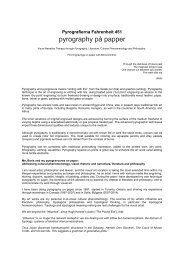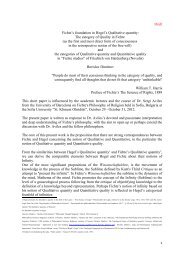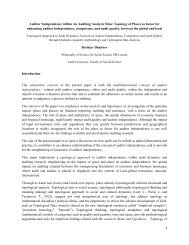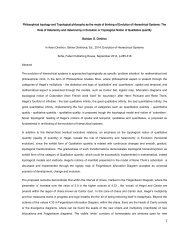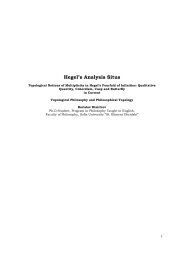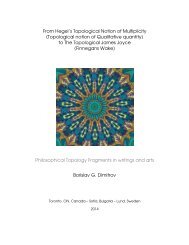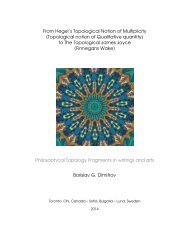Topological Ontology and Logic of Qualitative quantity
Qualitative quantity and BFO (Basic Formal Ontology) of /Barry Smith/ and YAMATO (Yet Another More Advanced Top-level Ontology) of /Riichiro Mizoguchi/
Qualitative quantity and BFO (Basic Formal Ontology) of /Barry Smith/ and YAMATO (Yet Another More Advanced Top-level Ontology) of /Riichiro Mizoguchi/
- No tags were found...
Create successful ePaper yourself
Turn your PDF publications into a flip-book with our unique Google optimized e-Paper software.
Leśniewski's student Alfred Tarski simplified Leśniewski's formalism. Other students (<strong>and</strong><br />
students <strong>of</strong> students) <strong>of</strong> Lesniewski elaborated this "Polish mereology" over the course <strong>of</strong> the<br />
20th century.<br />
The marriage <strong>of</strong> topological notions <strong>of</strong> boundaries <strong>and</strong> connection, <strong>and</strong> mereology results in<br />
mereotopology. The informal mereotopology is presented by Whitehead in his 1929’s work<br />
“Process <strong>and</strong> Reality”.<br />
According to Barry Smith, “..Husserl was at least implicitly aware <strong>of</strong> the topological aspect<br />
<strong>of</strong> his ideas, even if not under this name, is unsurprising given that he was a student <strong>of</strong> the<br />
mathematician Weierstrass in Berlin, <strong>and</strong> that it was Cantor (George Cantor), Husserl’s<br />
friend <strong>and</strong> colleague in Halle during the period when the <strong>Logic</strong>al Investigations were being<br />
written, who first defined the fundamental topological notions <strong>of</strong> open, closed, dense,<br />
perfect set, boundary <strong>of</strong> a set, accumulation point, <strong>and</strong> so on. Husserl consciously employed<br />
Cantor’s topological ideas, not least in his writings on the general theory <strong>of</strong> (extensive <strong>and</strong><br />
intensive) magnitudes which make up one preliminary stage on the road to the third<br />
Investigation. (See Husserl 1983, pp. 83f, 95, 413; 1900/01, “Prolegomena”, §§ 22 <strong>and</strong><br />
70.) 21<br />
According to Barry Smith “it is worth pointing out that the early development <strong>of</strong> topology<br />
on the part <strong>of</strong> Cantor <strong>and</strong> others was part <strong>of</strong> a wider project on the part <strong>of</strong> both<br />
mathematicians <strong>and</strong> philosophers in the nineteenth century to produce a general theory <strong>of</strong><br />
space - to find ways <strong>of</strong> constructing fruitful generalizations <strong>of</strong> such notions as extension,<br />
dimension, separation, neighbourhood, distance, proximity, continuity, <strong>and</strong> boundary.<br />
Husserl participated in this project with Stumpf <strong>and</strong> other students <strong>of</strong> Brentano such as<br />
Meinong. 22 Significantly, the 1906 paper on "The Origins <strong>of</strong> the Concept <strong>of</strong> Space" 23 , in<br />
which Riesz first formulated the closure axioms at the heart <strong>of</strong> topology is in fact a<br />
contribution to formal phenomenology, a study <strong>of</strong> the structures <strong>of</strong> spatial presentations, in<br />
which the attempt is made to specify the additional topological properties which must be<br />
possessed by a mathematical continuum if it is adequately to characterize the continuity <strong>and</strong><br />
order properties <strong>of</strong> our experience <strong>of</strong> space.” 24<br />
Husserl's <strong>Logic</strong>al Investigations (1900/01) contain a formal theory <strong>of</strong> part, whole <strong>and</strong><br />
dependence that is used by Husserl to provide a framework for the analysis <strong>of</strong> mind <strong>and</strong><br />
language <strong>of</strong> just the sort that is presupposed in the idea <strong>of</strong> a topological foundation for<br />
cognitive science. 25 makes itself felt already in his theory <strong>of</strong> dependence. 26 (Fine 1995.)<br />
The title <strong>of</strong> the third <strong>of</strong> Husserl's <strong>Logic</strong>al Investigations is "On the Theory <strong>of</strong> Wholes <strong>and</strong><br />
Parts" <strong>and</strong> it divides into two chapters: "The Difference between Independent <strong>and</strong><br />
21 Husserl, Edmund 1983 Studien zur Arithmetik und Geometrie. Texte aus dem Nachlass, 1886-1901, The<br />
Hague: Nijh<strong>of</strong>f (Husserliana XXI).<br />
22 Husserl, Edmund 1983 Studien zur Arithmetik und Geometrie. Texte aus dem Nachlass, 1886-1901, The<br />
Hague: Nijh<strong>of</strong>f (Husserliana XXI). pp. 275-300, 402-410; Stumpf, C. 1873 Über den psychologischen<br />
Ursprung der Raumvorstellung, Leipzig: Hirzel.; Meinong, Alexius von 1903 "Bermerkungen über die<br />
Farbenkörper und das Mischungsgesetz", Zeitschrift für Psychologie und Physiologie der Sinnesorgane, 33, 1-<br />
80, <strong>and</strong> in Meinong, Gesamtausgabe, vol. I, 497- 576. esp. §2: "Farbengeometrie und Farbenpsychologie", <strong>and</strong><br />
§5: "Der Farbenraum und seine Dimensionen".<br />
23 Riesz, F. 1906 "Die Genesis des Raumbegriffs", Mathematische und naturwissenschaftliche Berichte aus<br />
Ungarn, 24, 309-53.<br />
24 Barry Smith, <strong>Topological</strong> Foundations <strong>of</strong> Cognitive Science<br />
25 Smith, Barry (ed.) 1982 Parts <strong>and</strong> Moments. Studies in <strong>Logic</strong> <strong>and</strong> Formal <strong>Ontology</strong>, Munich: Philosophia.<br />
26 Fine, K. 1995 "Part-Whole", in B. Smith <strong>and</strong> D.W. Smith (eds.), The Cambridge Companion to Husserl,<br />
Cambridge: Cambridge University Press, 463-485.<br />
7





